Glean vs. Elasticsearch: Which AI is Best for Search and Knowledge Management?

Sorry, there were no results found for “”
Sorry, there were no results found for “”
Sorry, there were no results found for “”

AI-driven tools like Glean and Elasticsearch have revolutionized how we search, retrieve, and manage data.
But which one best suits your needs? Do you need a tool that excels at powering fast, accurate searches for your internal knowledge base or one that helps you create an intuitive and scalable wiki?
In this blog post, we’ll compare these two enterprise search tools: Glean vs. Elasticsearch, evaluate their features and performance, and discuss how they affect your knowledge management system to achieve relevant search results. We’ll also introduce a solid alternative to both tools—ClickUp!
🔎 Did You Know? The very first search engine, “Archie,” went live in 1990.
Built by university students Alan Emtage, Peter Deutsch, and Bill Heelen, Archie indexed files on public FTP servers, helping users locate and download them. Its name came from the word archive, with the ‘v’ dropped. Though groundbreaking, Archie gradually disappeared by the late 1990s.
| Feature | Glean | Elasticsearch | ⭐️ The Best Alternative: ClickUp |
| Search functionality | AI-powered search using large language models and machine learning to generate personalized, relevant results | High-performance full-text search across structured and unstructured data. Customizable via Query DSL for developers | Unified enterprise search across tasks, docs, comments, and more—no setup required. Built for teams who need fast, actionable results |
| Data ingestion and enrichment | Integrates with over 100 tools, organizing data into a unified experience for seamless search across platforms | Supports complex data transformations, mapping, custom tokenization, and indexing. Integrates well with big data tools like Hadoop and Spark | Automatically pulls in data from tasks, docs, and connected apps like Slack or Google Drive. No complex configuration needed |
| User experience and interface | Designed for non-technical users. Simple, intuitive interface with natural language prompts and data organization | Requires technical expertise. Full potential unlocked through understanding search algorithms and Query DSL | Built for everyday users—search is just one part of a familiar workspace where teams already manage work |
| Data security and compliance | Built-in governance tools for data access and privacy, ensuring compliance | More customizable security features, suitable for complex compliance and security needs | Granular permission controls across workspaces, folders, and tasks. Meets the needs of most teams without extra overhead |
| Scalability and performance | Optimized for AI-driven search across large datasets, but lacks fine-grained control and horizontal scaling | Horizontal scalability with a distributed architecture, ensuring high availability and fast performance even as data grows | Handles growing teams and projects with ease. Performance stays reliable even as workspaces expand in size and complexity |
Our editorial team follows a transparent, research-backed, and vendor-neutral process, so you can trust that our recommendations are based on real product value.
Here’s a detailed rundown of how we review software at ClickUp.
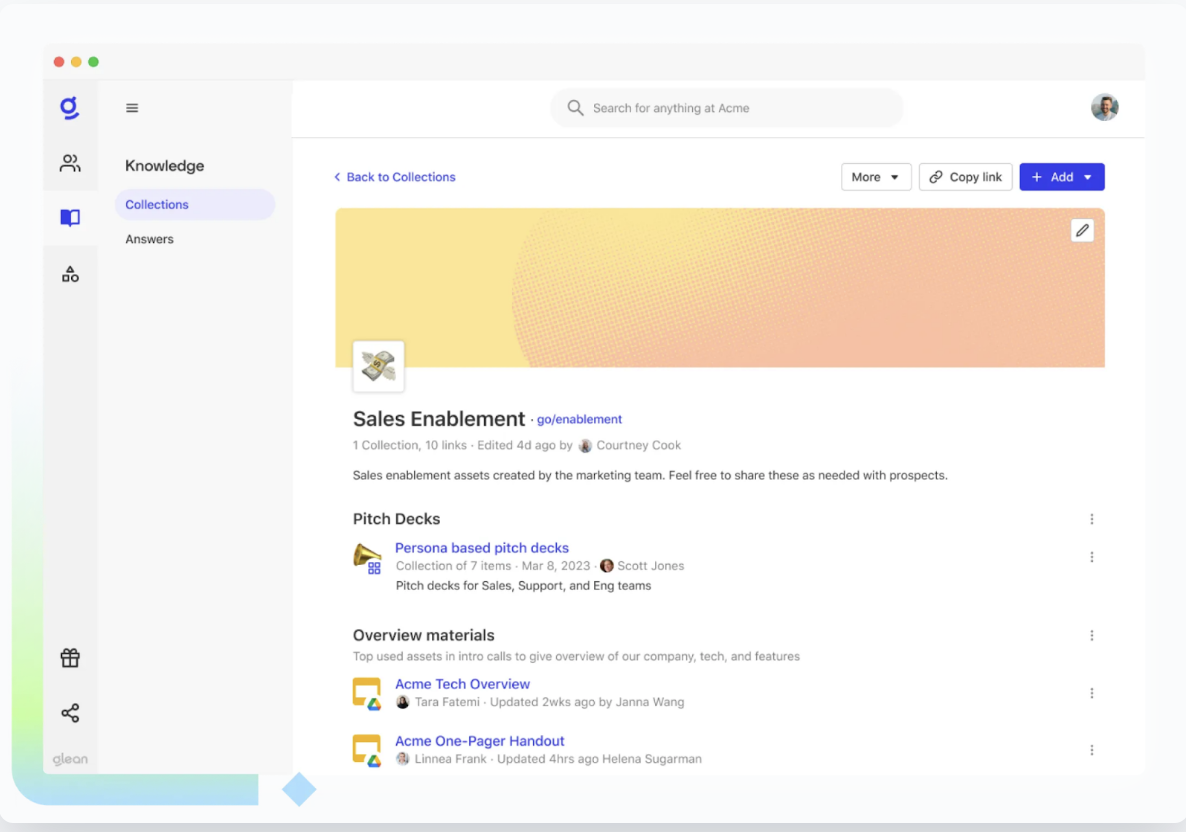
Glean is a work AI platform designed to help businesses stay on top of their data, tools, and tasks. It plugs into your company’s existing apps—think Google Workspace, Slack, Salesforce, and more—and uses AI to understand how your organization works. The result is a more intelligent search, better recommendations, and faster answers that make sense in your specific work context.
Whether you’re navigating messy workflows, hunting down scattered info, or just trying to work faster, Glean adapts to your needs. It even integrates smoothly into the apps your employees already use.
Glean’s prompt builder allows you to craft search commands in natural language. You can start with simple prompts to find documents or summarize their contents. However, more intricate tasks require advanced prompts.

This could traditionally take multiple systems or prompts. With advanced prompting, Glean allows you to break down the task into smaller steps, each with specific searches or actions, and then link them into a coherent, automated workflow. Each step builds upon the previous one, providing deeper insights as you progress.
📮 ClickUp Insight: 1 in 5 professionals spends 3+ hours daily just looking for files, messages, or additional context on their tasks. That’s nearly 40% of a full workweek wasted on something that should only take seconds!
ClickUp’s Enterprise Search unifies all your work—across tasks, docs, emails, and chats—so you can find exactly what you need when you need it without jumping between tools.
💫 Real Results: Teams like QubicaAMF reclaimed 5+ hours weekly using ClickUp—that’s over 250 hours annually per person—by eliminating outdated knowledge management processes. Imagine what your team could create with an extra week of productivity every quarter!
The prompt library is where all your custom prompts live. Instead of creating new ones from scratch, you can easily browse existing prompts built by your team. Each team member can discover and reuse effective prompts, reducing redundancy and speeding up adoption.
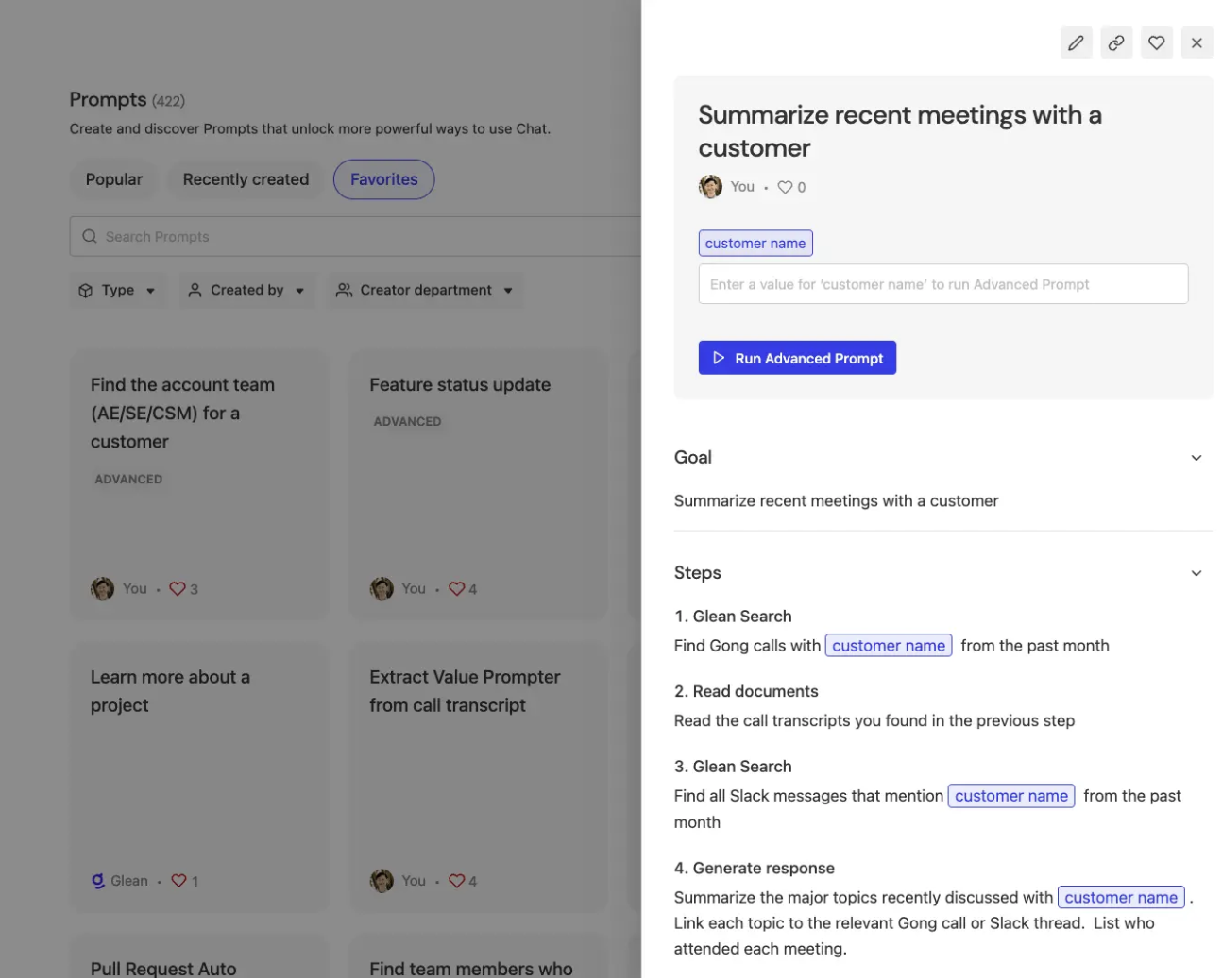
Glean even suggests popular prompts based on role and previous usage patterns. It’s like a shared knowledge base, constantly growing as your team learns how to create a wiki of AI-powered workflows. With suggestions to get started, you won’t have to waste time building everything from the ground up.
Glean’s platform is no-code, meaning anyone from sales to support can automate their workflows using simple natural language.
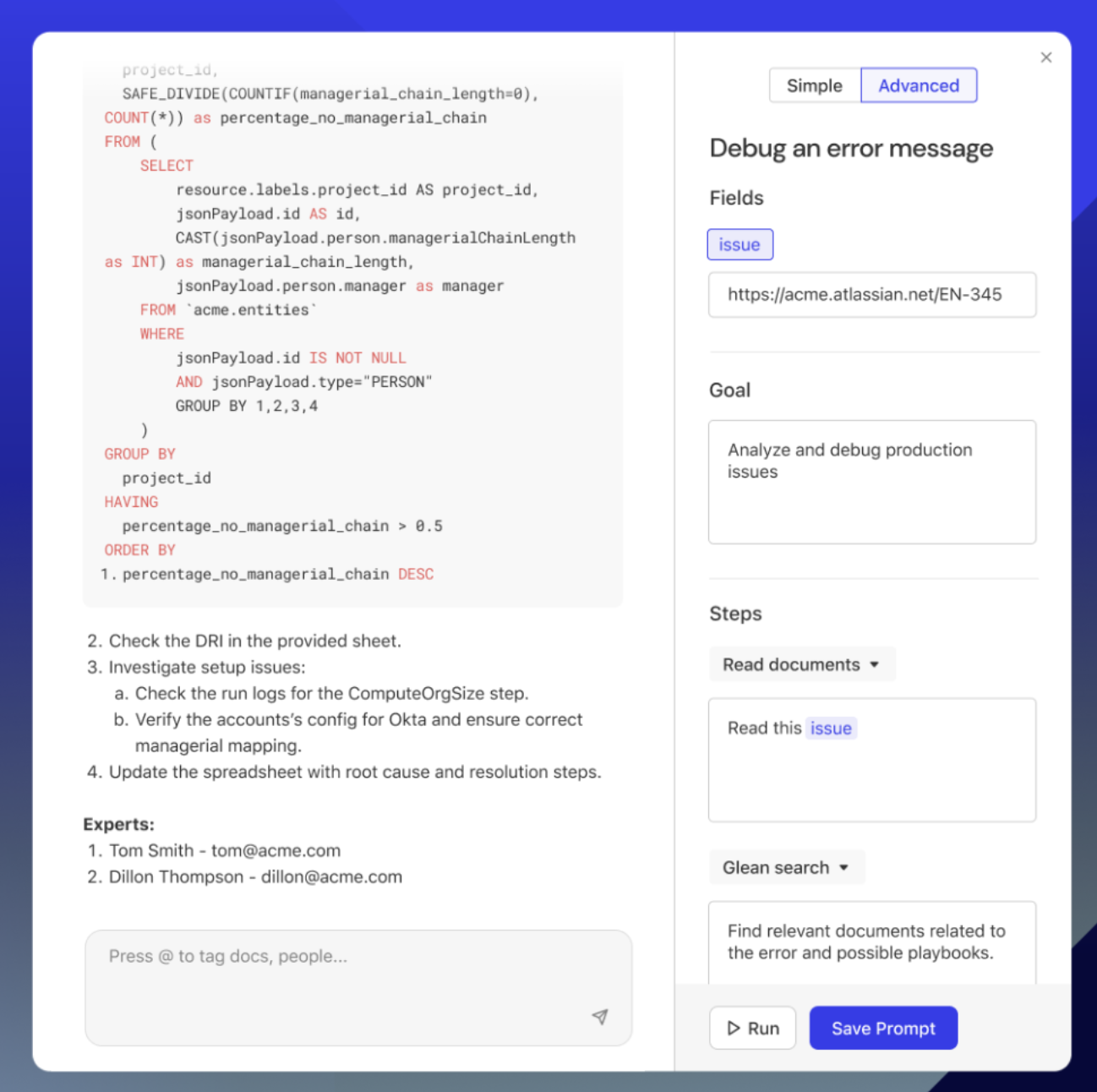
Whether it’s drafting a response to a customer, summarizing documents, or finding relevant info buried in past conversations, Glean understands the context and helps move work forward without extra setup or technical know-how.
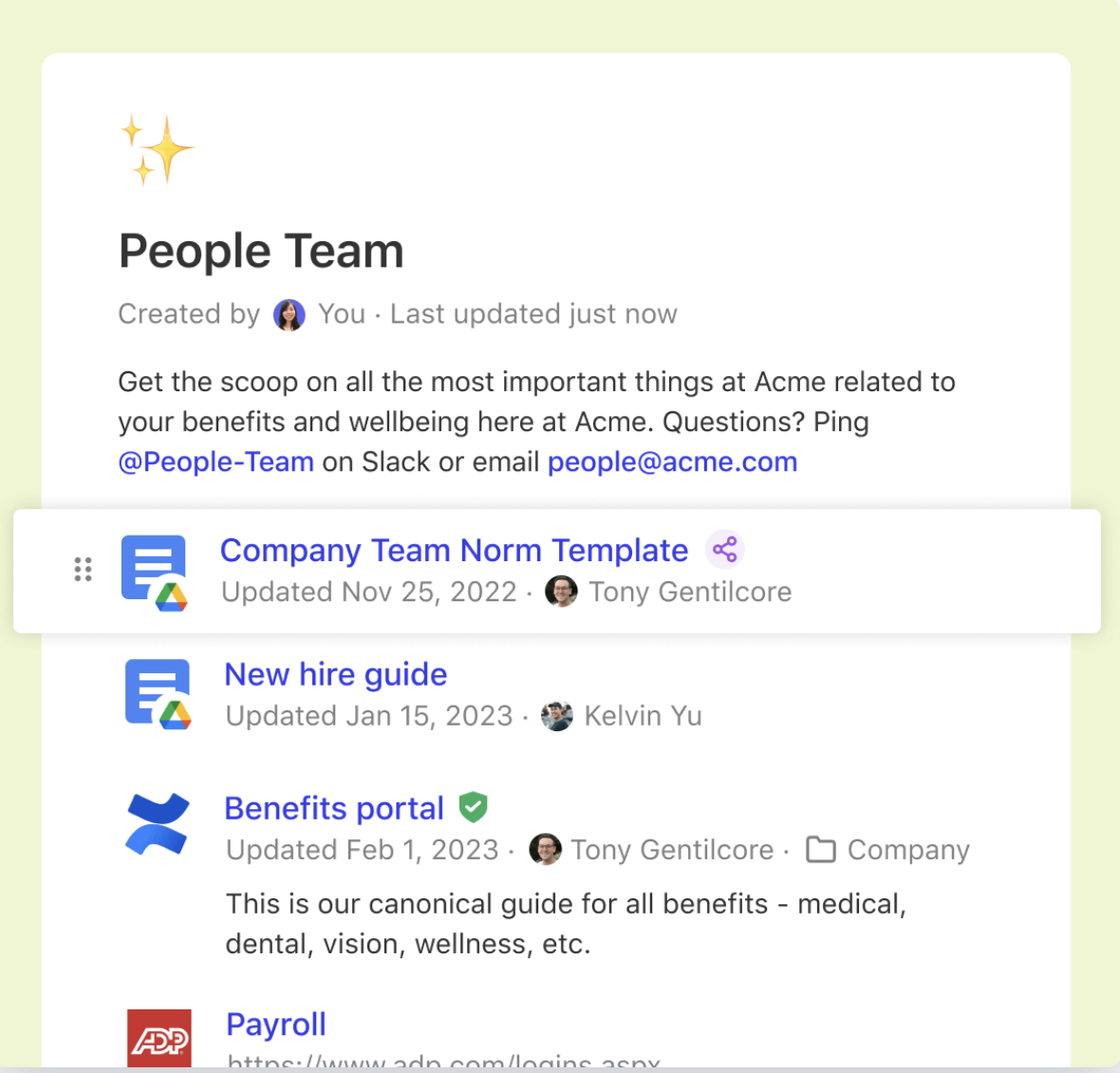
Glean helps reduce the clutter of scattered documents and hard-to-find links by allowing teams to organize key information in one place. With Collections, teams can group related files, notes, links, and conversations—regardless of where they originally came from, whether it’s Google Drive, Slack, or internal tools.
This makes it easier to keep track of project materials, share updates, and ensure that everyone has access to the same information without needing to search across multiple platforms.
📖 Also Read: Best Glean Competitors & Alternatives

Elasticsearch is an open-source, distributed search and analytics engine built to handle large volumes of structured and unstructured data. Think of it as Google, but for your internal business data. It pulls in and indexes information from multiple sources—like databases, logs, documents, or application data—so you can search it quickly and efficiently.
The platform doesn’t just match keywords; it ranks results based on relevance and context. Whether you’re trying to locate a specific document, analyze customer behavior, or track real-time system logs, Elasticsearch is designed to return the right data almost instantly—even across millions of records.
From integrating AI search capabilities to scaling your infrastructure, Elasticsearch offers the flexibility and performance you need. Below are some of its best features:

The Elasticsearch Relevance Engine (ESRE) adds semantic search capabilities to your applications, helping users find results based on meaning, not just keyword matches. It works out of the box without needing to retrain models for your specific domain, which makes it easier to get started.
You can also combine ESRE with external language models, customize it with your own transformer models, or build hybrid search experiences that blend traditional search with semantic relevance. This flexibility makes it useful for tailoring search functionality or automating AI workflows to different types of content and user needs.
💡 Pro Tip: Don’t underestimate metadata! It’s not just about what you’re searching—how things are tagged, categorized, and linked matters just as much. Strong metadata (like dates, authors, project tags, or access levels) helps refine search results, personalize relevance, and surface forgotten gems at just the right time.
Elasticsearch scales horizontally, meaning it grows with you. The experience remains consistent whether you’re operating on a single node or a 300-node cluster.
It handles millions of requests per second, ensuring indices and queries are distributed across the cluster for smooth, efficient operations. Elasticsearch’s scalability allows your data search capabilities to scale effortlessly if you’re wondering how to use AI for productivity.

Elasticsearch gives you flexibility in how and where your data lives. Depending on your needs, you can keep it local for fast querying or use more scalable options like low-cost S3 storage.
With runtime fields, adapting to changing data or bringing in new datasets on the fly is easy. For teams focused on better document management workflows, Elasticsearch makes it straightforward to organize, manage, and search across your data.
Features like cross-cluster replication ensure that a backup is always ready. Its distributed system is built for resilience and reliability. Your data stays available, even when something goes wrong.
📖 Also Read: Best Elasticsearch Alternatives
Glean and Elasticsearch tackle the same challenge: helping teams work more efficiently through workspace search. But they approach it differently.
Here’s a quick look at their differences:
| Glean | Elasticsearch |
| Intuitive, user-friendly solution with no-code AI capabilities | Highly customizable, scalable search platform |
| Can quickly organize and retrieve internal knowledge with personalized answers and context-aware results | Can handle large datasets and complex queries with full-text enterprise search platform flexibility |
| Empowers non-technical users with AI-powered search, data analytics, and natural language prompts | Offers advanced security features for compliance and complex data governance |
| Streamlines knowledge management with smart collections and Go Links for fast access | Supports large-scale data and offers a distributed architecture for horizontal scaling |
Now, let’s take a deep dive into the key features to see where each tool excels.
Glean is an AI-powered enterprise search platform that uses LLMs and machine learning to generate more personalized, accurate search results. It focuses on providing relevant answers by understanding the context behind each query.
On the other hand, Elasticsearch focuses on fast, high-performance full-text search across structured and unstructured data. Its Query DSL (Domain Specific Language) allows for detailed query customization, giving developers precise control over search queries and ranking results.
🏆 Winner: Glean. Its AI-driven search provides more personalized and context-aware results, making it more effective for non-technical users who want intuitive, relevant answers without manually tweaking search queries.
On the one hand, Glean integrates with over 100 tools, organizing data into a unified experience for seamless search across platforms. On the other hand, it provides high flexibility in data ingestion.
Its ingestion pipelines support complex data transformations and mapping, allowing users to set custom tokenization and indexing processes tailored to their needs.
Elasticsearch integrates seamlessly with big data tools like Hadoop and Spark, making it ideal for larger-scale data operations.
🏆 Winner: Elasticsearch wins here due to its customizable and granular control over data ingestion pipelines, allowing businesses to tailor the data indexing process precisely to their needs.
Glean’s interface is designed to be user-friendly and intuitive. It’s built with non-technical users in mind, so you don’t need specialized knowledge to interact with it. Features like natural language prompts and the ability to organize data into collections make Glean highly accessible.
Elasticsearch, however, is much more technical. While it provides robust functionality, users must deeply understand search algorithms and the Query DSL to unlock its full potential.
🏆 Winner: Glean wins here due to its ability to provide a user-friendly interface that requires no technical expertise, allowing teams to find information and stay productive quickly.
Glean has built-in governance tools that ensure proper data access and privacy, helping organizations comply with internal policies and external regulations.
Conversely, Elasticsearch offers more robust and highly customizable security features, making it a better choice for enterprises with complex security and compliance requirements.
🏆 Winner: Elasticsearch. It’s the clear winner if you need more robust, highly customizable security features.
Glean optimizes AI-driven workplace search across large data sets and provides good scalability. However, it doesn’t offer the same efficient search capabilities, fine-grained control over system resources, and horizontal scaling as Elasticsearch.
Elasticsearch uses a distributed architecture built for horizontal scalability, allowing it to scale effortlessly across multiple nodes. This ensures high availability and fast performance even as data grows.
🏆 Winner: Elasticsearch is the winner here, with its distributed, scalable architecture that ensures smooth performance across large datasets and multiple nodes.
📖 Also Read: Best AI Collaboration Tools to Use
Reddit users often have strong opinions about the differences between Glean and Elasticsearch, and their views are shaped by specific needs and workflows.
The general sentiment often leans toward Glean for users looking for simplicity and quick integration with popular tools. For example, one Reddit user, Old_Cauliflower6316, mentions on r/Llamaindex:
In my opinion, if your use case is simple, I’d go with a product like Glean. They have a large customer base, proven value, and flexibility. By ‘simple,’ I mean integrating with popular data sources like Slack, Google Drive, Confluence, Notion, JIRA, etc., and offering a familiar chatbot/search engine experience.
Conversely, Elasticsearch is favored by users who need robust, customizable search capabilities, especially in larger, more complex environments. Many Redditors appreciate Elasticsearch’s flexibility, scalability, and open-source nature, which provides greater control over indexing and user queries. A Reddit user, elk-content-share, shares on r/elasticsearch:
App Search is a search solution from Elastic on top of Elasticsearch to help with integrating the search engine into a custom application.
This highlights Elasticsearch’s strengths in custom applications and handling large-scale, diverse datasets that require granular control over search indexing and performance.
However, a few users had neutral perspectives on both search engines. For example, unixmonster mentions:
I work with Glean a ton and It is super simple to set up and they have a rich set of APIs to enable you to build in-house tools if you choose
Similarly, Draxenato writes about Elasticsearch:
Like everything ELS has its strengths and weaknesses. It’s well suited to a high velocity, high volume, low datastore scenario. It’ll render a shedload of metrics in meaningful, human readable fashion very quickly, think firewall logs, lots of small documents with high frequency. It can be tweaked to make it more efficient for other use cases, i.e., a large library of PDFs, but you might want to consider other solutions if that’s your use case.
According to Reddit, the bottom line is that if you want something that works out of the box with tools your team already uses, Glean keeps it simple. But if you enjoy fine-tuning every gear under the hood, Elasticsearch might be more your speed.
🧠 Fun Fact: Google’s original algorithm for ranking websites, PageRank, was named after Larry Page, not just because it ranks pages, but also after its co-creator, Page.
If you combine the strengths of Glean and Elasticsearch, the result looks like ClickUp!
Work today is broken. 60% of our time is spent sharing, searching for, and updating relevant information across different tools. Our projects, documentation, and communication are scattered across disconnected tools that drain productivity.
ClickUp solves this problem with the World’s First Converged AI Workspace, which combines projects, knowledge, and chat in one place—all powered by the world’s most complete work AI.
Today, over three million teams use ClickUp to work faster with more efficient workflows, centralized knowledge, and focus-driven chat that eliminates distractions and unlocks organizational productivity.
Let’s get into the specifics.
ClickUp wins by a huge margin when it comes to search performance. With ClickUp Enterprise Search, you get a unified, intelligent search engine that integrates with every tool your team uses.
Unlike Glean, which sometimes struggles to surface the correct information, ClickUp offers real-time, relevant results with Connected AI.
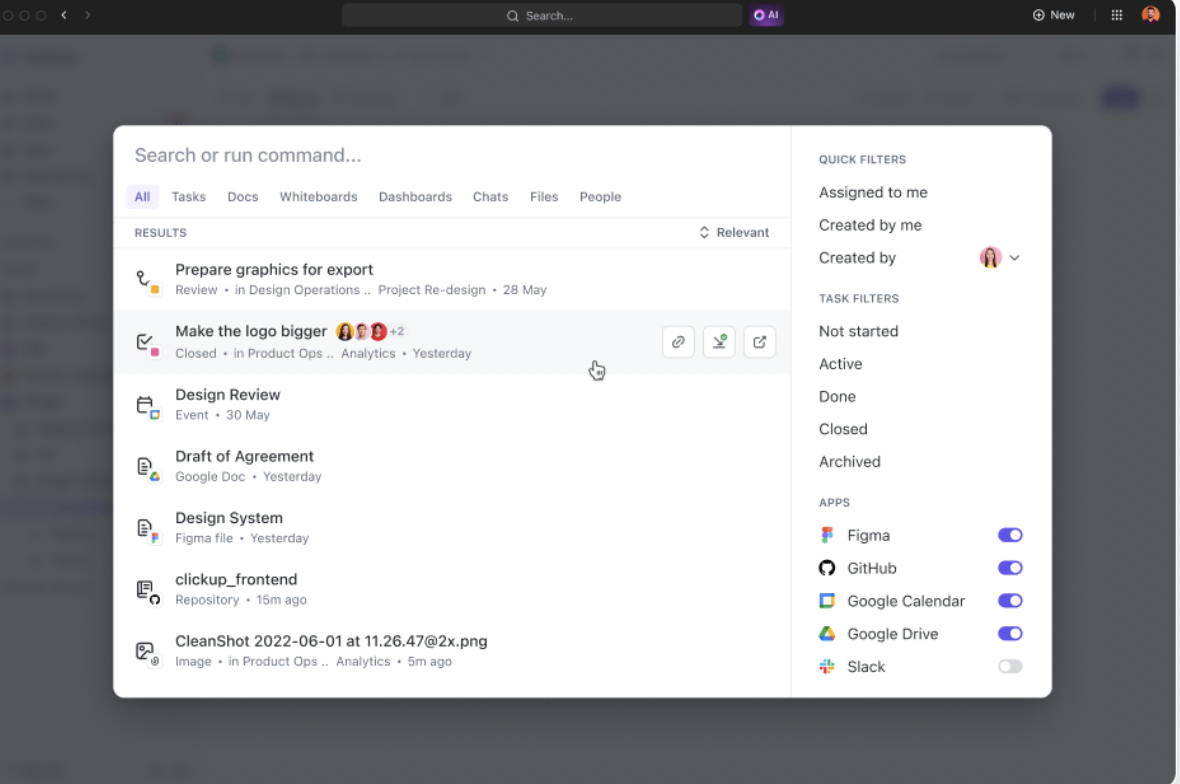
Here’s how ClickUp’s Enterprise Search shines:
With ClickUp, you can instantly search across tasks, docs, wikis, chats, goals, and even integrated third-party tools—all from a single platform. This means no more switching between apps, scouring through docs, or losing track of information scattered across silos, aka work sprawl. All that ends with AI-powered search.
ClickUp Brain is ClickUp’s built-in AI assistant that transforms how teams find and use knowledge. It goes beyond keyword search by understanding context, surfacing relevant information, and even answering questions in natural language.
Whether you’re looking for a specific document, a project update, or historical decisions, ClickUp Brain delivers instant, accurate results—something that requires significant customization in Elasticsearch and is less intuitive in Glean.
It can read through task histories and chat and decipher the real-time answer to any question you search for!
Here’s a sample of ClickUp Brain at work👇
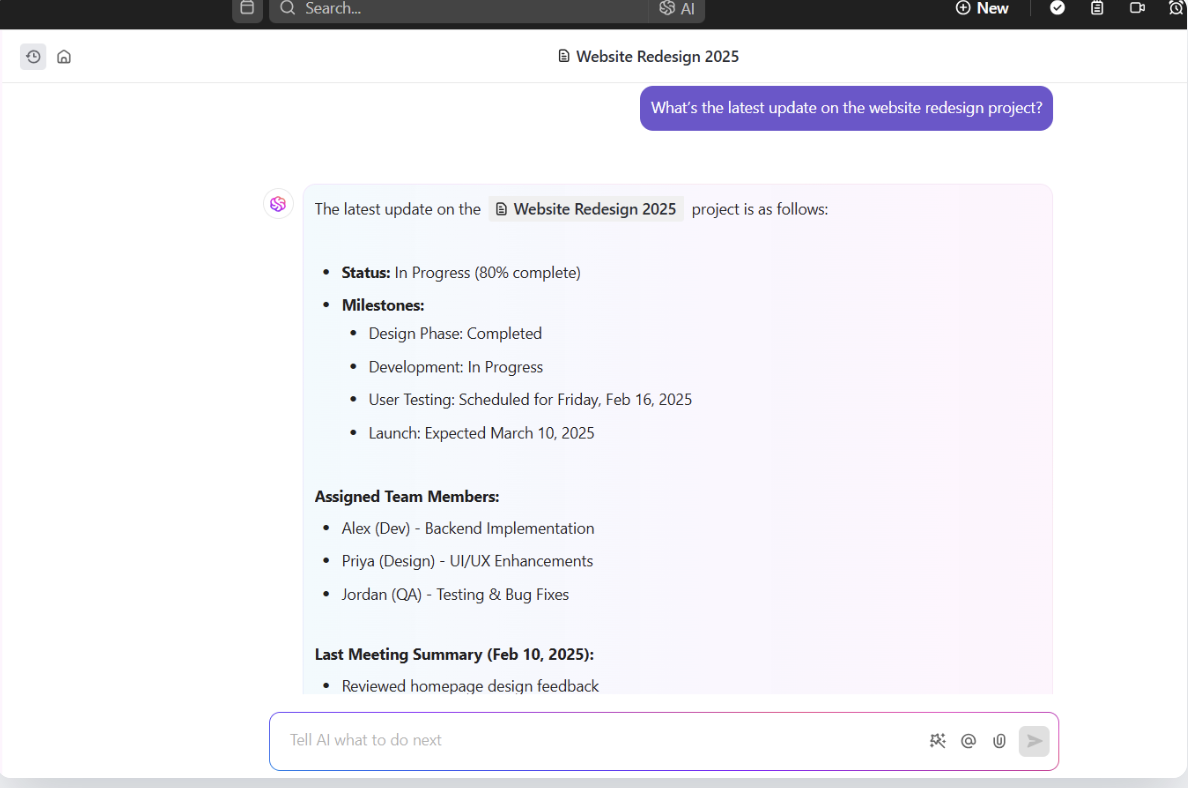
With ClickUp Brain, you get:
For organizations that need even more intelligence, ClickUp Brain MAX offers advanced AI capabilities, including deep semantic search, automated summaries, and smart recommendations. It can analyze vast amounts of data across your workspace, making it easy to discover insights, trends, and connections that would otherwise be buried.
📮 ClickUp Insight: Can’t find the answer? Just ask a colleague—but at what cost? Nearly half of employees regularly interrupt teammates for information. And every time they do? It takes up to 23 minutes to refocus. That’s hours of lost productivity every week.
This is where you need a centralized brain for your organization. An AI-powered colleague, aka ClickUp Brain can bring you everything you need in one place—answers, insights, files, context, you name it!
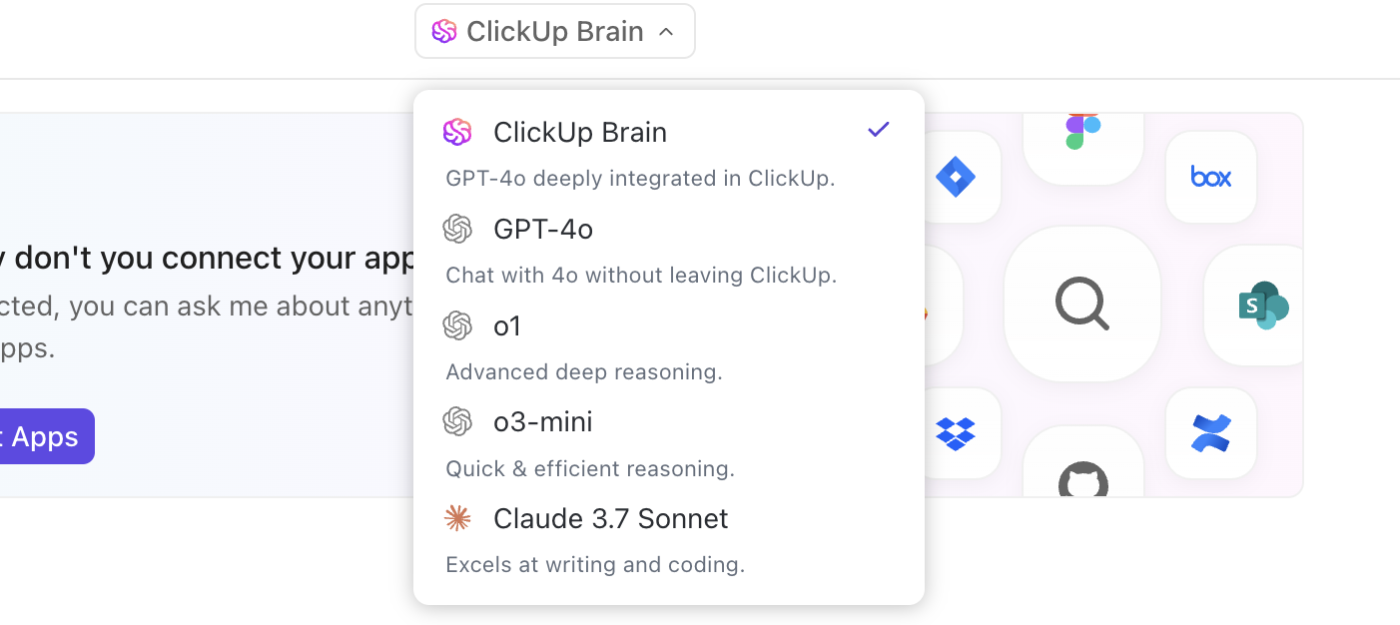
Unlike tools like Glean, which pair you with a single built-in model, or Elasticsearch, which requires developer setup to integrate AI, ClickUp Brain lets you switch between premium external AI models, like ChatGPT, Gemini, and Claude, right inside your workspace—no tab-hopping, no extra logins. Want to draft content with Claude or troubleshoot code with ChatGPT? You’re covered.
This flexibility means your AI adapts to the task and your style. And as newer, smarter models emerge, ClickUp Brain is ready to bring them onboard—so your AI assistant evolves right alongside your work.
Managing knowledge doesn’t need to be complicated. ClickUp Knowledge Management is built to be simple but powerful. With ClickUp, you can store, organize, and collaborate on company knowledge without the friction you might face in Glean or Elasticsearch.
Here’s what makes it stand out:

If you want to take it further, ClickUp offers a rich library of templates, including knowledge base templates, which can streamline your progress.
For instance, the ClickUp Knowledge Base Template centralizes FAQs, project details, and critical insights in one searchable hub. It reduces downtime and eliminates information silos. With real-time collaboration, intuitive organization, and fully customizable layouts, it fits seamlessly into your team’s unique workflows, making knowledge sharing efficient and effortless.
Here’s how you can use this template:
But that’s not all! ClickUp’s Connected Search ensures you can locate specific information instantly, so you won’t have to dig through lengthy documents or scattered files.
TravelLocal’s Product Manager, Thomas Clifford, shared how ClickUp became their everything solution for task management, knowledge base, and more:
We use ClickUp for all our project and task management, as well as a knowledge base. It has also been adopted for monitoring and updating our OKR framework and several other use cases, including flow charts and holiday request forms and workflows. It is great to be able to serve all of these within one product, as things can very easily be interlinked.
With ClickUp Automations, you can also automate repetitive tasks like assigning tickets, updating statuses, and sending notifications. HR teams, for instance, can automate the review process for policy updates, while customer support teams can automatically escalate tickets based on sentiment analysis.
But ClickUp doesn’t stop there. It also brings added functionality to ClickUp Docs, turning them from simple note-taking tools into dynamic spaces for collaboration.
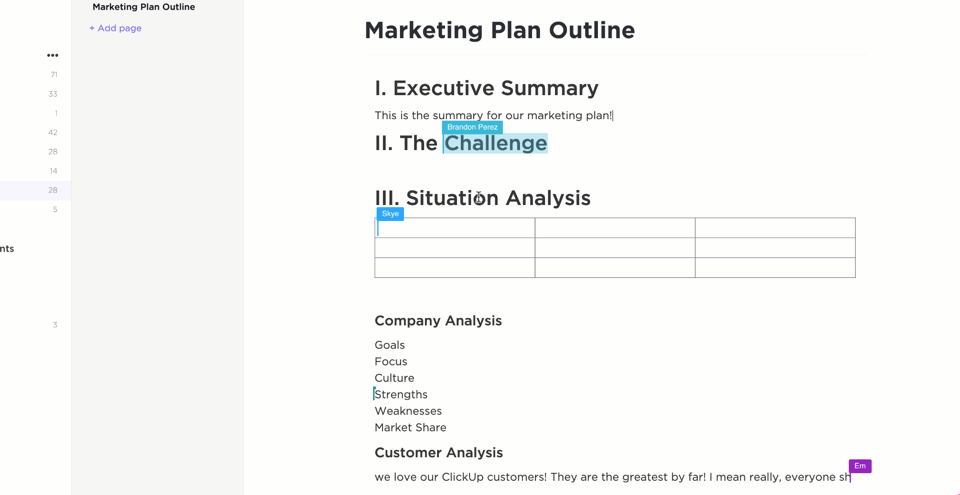
Marketing teams, for example, can assign tasks directly within Docs, ensuring everyone knows their role in the project. Product managers can also directly link user stories, comments, and mockups to feature documentation, transforming static docs into interactive roadmaps.
📖 Also Read: Inside ClickUp Brain for Teams: Top Tools for Knowledge Sharing, Project Automation, & Writing
While tools like Glean offer quick search functionality and Elasticsearch excels at handling massive data queries, ClickUp represents the best of both worlds. Its AI-powered search, seamless integrations, and document collaboration all exist under one roof.
With ClickUp, your team gets a complete solution beyond searching and indexing to automate workflows, manage projects, and keep your knowledge base organized and accessible with up-to-date information.
Sign up for ClickUp for free today and see the transformation firsthand!
© 2025 ClickUp